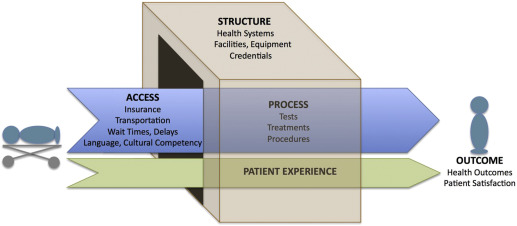Introduction
Increasingly there has been pressure on hospitals and physicians to measure quality and prove the adequacy of the care they are delivering. This pressure comes from insurers and consumers who want to be sure they are not only obtaining good outcomes but also obtaining good value for dollars spent. While the need to spend wisely is understandable, the dilemma remains of how to prove the quality of care provided is high. That is to say, is quality of care measurable?
The Institute of Medicine defines quality of care as “the degree to which heath care services for individuals and populations increase the likelihood of desired health outcomes and are consistent with current professional knowledge.” According to Agency for Healthcare Research and Quality (AHRQ), “quality measures” are mechanisms that enable the user to quantify a selected aspect of care by comparing it to an evidence-based criterion. A “clinical performance measure” is a type of quality measure that assesses the degree to which a provider competently and safely delivers a clinical service to a patient within the optimal time period. Performance measures have been created by a number of advocacy coalitions, patient safety institutions, government agencies, and professional organizations. To measure performance adequately and accurately, process, structure/capacity, access, patient satisfaction, and outcome measures must not only be created, but must be relevant, scientifically sound, feasible, actionable, accurately measurable (reliable and valid), and ultimately result in improved outcomes for the population. In the case of outcome measures, they may need to be risk-adjusted as well. To paraphrase Einstein, everything should be made as simple as possible, but not any simpler.
Various types of quality measures exist as summarized in the Figure .

Structure/capacity measures are designed to assess whether the capacity to perform a service or function exists in a particular system (eg, what proportion of providers have undergone a certain postpartum hemorrhage (PPH) training or whether a particular service is available at an institution such as massive transfusion policy or PPH cart).
Process measures are designed to assess the frequency of usage of a particular clinical process; they are calculated using the number of patients eligible for a particular service in the denominator and the number of patient who actually receive the service in the numerator (eg, the proportion of GBS carriers who received antibiotics during labor).
Outcome measures are created by assessing the frequency or prevalence of a specific outcome in a given population (eg, number of third- or fourth-degree tears, brachial plexus injuries, or postpartum intensive care unit [ICU] admissions per 1000 deliveries).
Access measures assess the attainment by patients of timely care as well as the delays and barriers (educational, financial, prejudiced, geographic, or environmental) that may result in failure to obtain care.
Finally, patient experience/satisfaction measures assess the patient’s perception and experience of health care delivery. These measures are typically dependent on patient survey data and are not obtainable by typical administrative data generated by a hospital.
Using measures for quality improvement involves 6 steps: identifying deficiencies or areas for improvement, selecting measures to assess these areas, obtaining preintervention baseline data, performing an intervention, performing postintervention measurement, and finally, refining the measurement and the intervention. Quality improvement may involve assessment of internal processes at a single institution or may involve assessments across different institutions that result in regional, state, or national comparisons.
Having established that it is desirable and conceptually possible to measure quality of care, this article will review current approaches to measure quality of care in obstetrics and preview new measures on the horizon. Additionally, systems for using and maintaining quality measures will be discussed.
Stay updated, free articles. Join our Telegram channel

Full access? Get Clinical Tree


